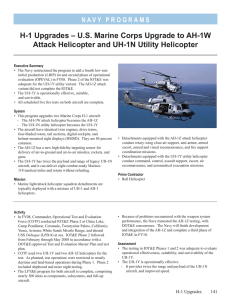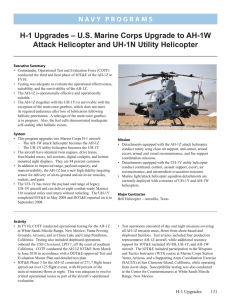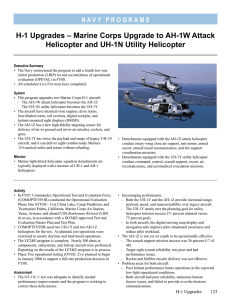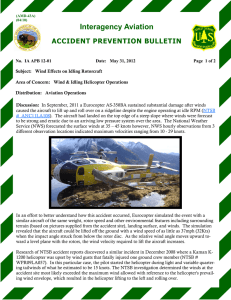USMC H-1 Upgrades (UH-1Y)
advertisement
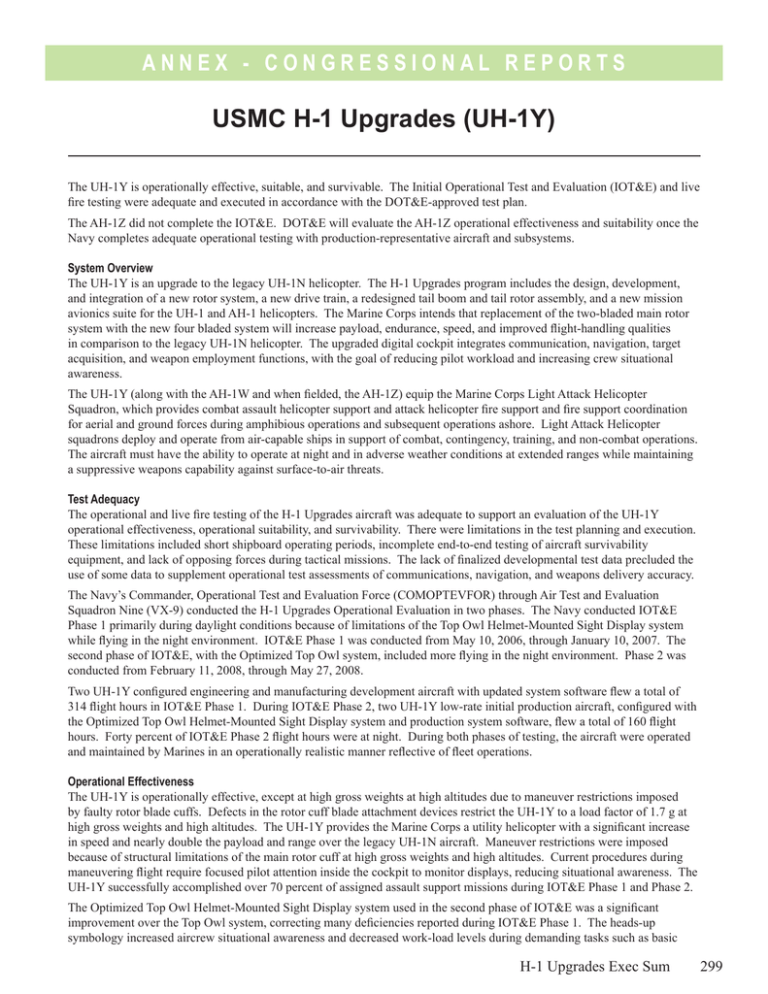
A nn e x - c o ng r e ss i o nal r e p o r ts USMC H-1 Upgrades (UH-1Y) The UH-1Y is operationally effective, suitable, and survivable. The Initial Operational Test and Evaluation (IOT&E) and live fire testing were adequate and executed in accordance with the DOT&E-approved test plan. The AH-1Z did not complete the IOT&E. DOT&E will evaluate the AH-1Z operational effectiveness and suitability once the Navy completes adequate operational testing with production-representative aircraft and subsystems. System Overview The UH-1Y is an upgrade to the legacy UH-1N helicopter. The H-1 Upgrades program includes the design, development, and integration of a new rotor system, a new drive train, a redesigned tail boom and tail rotor assembly, and a new mission avionics suite for the UH-1 and AH-1 helicopters. The Marine Corps intends that replacement of the two-bladed main rotor system with the new four bladed system will increase payload, endurance, speed, and improved flight-handling qualities in comparison to the legacy UH-1N helicopter. The upgraded digital cockpit integrates communication, navigation, target acquisition, and weapon employment functions, with the goal of reducing pilot workload and increasing crew situational awareness. The UH-1Y (along with the AH-1W and when fielded, the AH-1Z) equip the Marine Corps Light Attack Helicopter Squadron, which provides combat assault helicopter support and attack helicopter fire support and fire support coordination for aerial and ground forces during amphibious operations and subsequent operations ashore. Light Attack Helicopter squadrons deploy and operate from air-capable ships in support of combat, contingency, training, and non-combat operations. The aircraft must have the ability to operate at night and in adverse weather conditions at extended ranges while maintaining a suppressive weapons capability against surface-to-air threats. Test Adequacy The operational and live fire testing of the H-1 Upgrades aircraft was adequate to support an evaluation of the UH-1Y operational effectiveness, operational suitability, and survivability. There were limitations in the test planning and execution. These limitations included short shipboard operating periods, incomplete end-to-end testing of aircraft survivability equipment, and lack of opposing forces during tactical missions. The lack of finalized developmental test data precluded the use of some data to supplement operational test assessments of communications, navigation, and weapons delivery accuracy. The Navy’s Commander, Operational Test and Evaluation Force (COMOPTEVFOR) through Air Test and Evaluation Squadron Nine (VX-9) conducted the H-1 Upgrades Operational Evaluation in two phases. The Navy conducted IOT&E Phase 1 primarily during daylight conditions because of limitations of the Top Owl Helmet-Mounted Sight Display system while flying in the night environment. IOT&E Phase 1 was conducted from May 10, 2006, through January 10, 2007. The second phase of IOT&E, with the Optimized Top Owl system, included more flying in the night environment. Phase 2 was conducted from February 11, 2008, through May 27, 2008. Two UH-1Y configured engineering and manufacturing development aircraft with updated system software flew a total of 314 flight hours in IOT&E Phase 1. During IOT&E Phase 2, two UH-1Y low-rate initial production aircraft, configured with the Optimized Top Owl Helmet-Mounted Sight Display system and production system software, flew a total of 160 flight hours. Forty percent of IOT&E Phase 2 flight hours were at night. During both phases of testing, the aircraft were operated and maintained by Marines in an operationally realistic manner reflective of fleet operations. Operational Effectiveness The UH-1Y is operationally effective, except at high gross weights at high altitudes due to maneuver restrictions imposed by faulty rotor blade cuffs. Defects in the rotor cuff blade attachment devices restrict the UH-1Y to a load factor of 1.7 g at high gross weights and high altitudes. The UH-1Y provides the Marine Corps a utility helicopter with a significant increase in speed and nearly double the payload and range over the legacy UH-1N aircraft. Maneuver restrictions were imposed because of structural limitations of the main rotor cuff at high gross weights and high altitudes. Current procedures during maneuvering flight require focused pilot attention inside the cockpit to monitor displays, reducing situational awareness. The UH-1Y successfully accomplished over 70 percent of assigned assault support missions during IOT&E Phase 1 and Phase 2. The Optimized Top Owl Helmet-Mounted Sight Display system used in the second phase of IOT&E was a significant improvement over the Top Owl system, correcting many deficiencies reported during IOT&E Phase 1. The heads-up symbology increased aircrew situational awareness and decreased work-load levels during demanding tasks such as basic H-1 Upgrades Exec Sum 299 A nn e x - c o ng r e ss i o nal r e p o r ts navigation and shipboard approaches. Weapons delivery accuracy was not improved with the use of the Optimized Top Owl system. Limited data collected during operational testing suggest that manually-aimed fire is more accurate, although both methods result in average miss distances greatly increased from that of the UH-1N using spotting and adjust fires methods. The digital cockpit improves crew situational awareness, but the avionics upgrade needs further improvements to eliminate excessive pilot workload. Mission planning systems supported mission execution, but imposed unnecessary workload, especially during pre-mission planning. Better integration of mission planning and cockpit systems would reduce crew workload and enhance mission effectiveness. The thermal imaging sensor display was an improvement over that of the UH‑1N, but target recording and reporting were difficult. Operational Suitability The UH-1Y is operationally suitable. During operational testing, the UH-1Y exceeded reliability thresholds for mean flight hours between failure and mean flight hours between abort. The UH-1Y requires less unscheduled maintenance support, but slightly more overall maintenance support than the UH-1N. Suitability improved during IOT&E Phase 2. While availability was increased over IOT&E Phase 1, it fell short of the required threshold because of an immature supply system and shortage of repair parts. Maintenance was hampered by incomplete and inaccurate technical publications. The aircraft has shipboard compatibility deficiencies with the blade fold system. Currently the satellite communications system is not effective. Many human factors issues remain with the Optimized Top Owl system, which should be corrected before operational deployment of the UH-1Y: • Situational awareness • Crew coordination • Passenger seating • Environmental control The rotor system is operating under greatly restricted life-cycle times because of structural limitations on its principal components, the yokes and cuffs. The Navy intended these parts to last 10,000 flight hours. In operational use, they are being replaced after 700 to 1,200 hours. This costs not only the actual replacement cost, but also the maintenance hours and the aircraft down time. This greatly reduced life expectancy should be corrected as soon as possible. Survivability Operational and live fire testing indicate that the UH-1Y aircraft is survivable in most expected threat environments. A number of features enhance the operational survivability of the UH-1Y in combat operations by reducing either the susceptibility (hit avoidance) or the vulnerability (hit tolerance) of the aircraft compared to the legacy UH 1N. The UH-1Y aircraft is ballistically tolerant to the required threat with several notable exceptions: • Susceptibility testing is incomplete. Initial infrared signatures compare favorably with baseline aircraft, but end-to-end demonstration of APR-39 radar warning and AAR-47 infrared countermeasure effectiveness is still needed. • Operational testing did not include live opposing forces. System performance in a reactive threat environment is not known. • Vulnerability testing indicates that some improvements are needed for flight critical components including: transmission, fuel cell, flare dispensers, and fire suppression in the dry bays. Recommendations The Navy should consider these recommendations for improvement: Operational Effectiveness • On a priority basis, replace the rotor blade cuffs to eliminate the maneuvering restrictions at high gross weights and high altitudes. Expand the flight envelope to the required limits. • Improve weapons delivery accuracy with the Optimized Top Owl system. • Increase load capacity of mounting point for Improved Defensive Armament System so that the full 1,000 pounds can be carried. For crew-served weapons, the Navy should address the gun depression angle limitation imposed by the Improved Defensive Armament System. Operational Suitability • Complete analysis and redesign of rotor cuffs for improved structural integrity, decreased life-cycle costs, and increased aircraft maneuverability. In the interim, improve approaching g-limit warning systems and training in order to reduce focused pilot attention on g-meter during maneuvering flights. • Improve human factors (neck strain and cord management) of the Optimized Top Owl system and provide a helmet test set and complete documentation. • Complete electromagnetic environmental effects testing to resolve shipboard compatibility issues. 300 H-1 Upgrades Exec Sum A nn e x - c o ng r e ss i o nal r e p o r ts • • • • Resolve the issue of clearance between the cyclic control and the left seat pilot’s leg. Reduce excessive cockpit heat as a result of an expanded avionics suite. Address inadequate ballistic eye coverage for the helmet-mounted sight display. Improve training and documentation for Optimized Top Owl system procedures, Advanced Memory Unit trouble‑shooting codes, and structural repair, schematics, and transportability manuals. Survivability • Conduct end-to-end testing of Aircraft Survivability Equipment. • Test the main rotor gearbox, if an improved version is incorporated, in a full-up system-level test. Vulnerability Deficiencies • Redesign of transmission housing. • Consider self-seal material to full height of fuel cells. • Ensure adequate self-sealing of fuel bladders per Mil Standard T 27422. • Consider adding fire extinguishing system as backup to current powder panels in dry bays. • Add fire suppression/extinguishing system to main transmission bay. • Investigate methods for suppressing/extinguishing fires in oil cooler bay. • Consider adding backup fire extinguishing bottles in engine bay. • Consider reducing vulnerability of main rotor actuators. • Consider relocation/redesign of forward flare buckets. • Exclude combustion products from flares ignited by threat from occupied spaces and flammable materials. H-1 Upgrades Exec Sum 301 A nn e x - c o ng r e ss i o nal r e p o r ts 302
